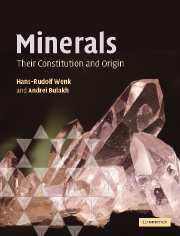Book contents
- Frontmatter
- Contents
- Preface
- Acknowledgments
- Figure credits
- Part I Structural features of minerals
- Part II Physical investigation of minerals
- 7 Experimental studies of crystal structures. X-ray diffraction
- 8 Physical properties
- 9 Optical properties
- 10 Identification of minerals with the petrographic microscope
- 11 Color
- 12 Additional analytical methods
- 13 Mechanical properties and deformation
- Part III Variety of minerals and mineral-forming processes
- Part IV A systematic look at mineral groups
- Part V Applied mineralogy
- Appendices
- Glossary
- References
- Index
- Plate section
- References
11 - Color
from Part II - Physical investigation of minerals
- Frontmatter
- Contents
- Preface
- Acknowledgments
- Figure credits
- Part I Structural features of minerals
- Part II Physical investigation of minerals
- 7 Experimental studies of crystal structures. X-ray diffraction
- 8 Physical properties
- 9 Optical properties
- 10 Identification of minerals with the petrographic microscope
- 11 Color
- 12 Additional analytical methods
- 13 Mechanical properties and deformation
- Part III Variety of minerals and mineral-forming processes
- Part IV A systematic look at mineral groups
- Part V Applied mineralogy
- Appendices
- Glossary
- References
- Index
- Plate section
- References
Summary
Introduction
In Chapters 9 and 10 we used the interaction of light with crystals to characterize minerals with a transmitted light petrographic microscope. We noted that properties such as refractive index and birefringence are intrinsic properties of crystals and can be used for identification purposes. We also introduced the concept of color when describing properties such as pleochroism or interference colors, but we have not really dealt with the apparent color of macroscopic minerals. The color of a mineral is our perception of the wavelengths of light that are either reflected or transmitted through the material and that reach our eye. Color is one of the most striking features of minerals and is most readily observed. There are many reasons why a mineral displays a particular apparent color, all related to the interaction of light with the crystal. Light may be transmitted, absorbed, scattered, refracted, or reflected by a crystal. As we will see, however, color is generally not a bulk property determined by the general structure, as for example is the refractive index, but rather depends on the trace elements present, or on mineral defects. For example, a mineral with the general composition Al2O3 may be white (as corundum), red (as ruby, Plate 13b), or blue (as sapphire, Plate 13c,d), with only very minor differences in composition. The same is true for quartz, basically SiO2, which can be colorless-transparent, purple (as amethyst), yellow (as citrine), pink (as rose quartz), brown (as smoky quartz), black (as morion), or green (as chrysoprase).
- Type
- Chapter
- Information
- MineralsTheir Constitution and Origin, pp. 208 - 216Publisher: Cambridge University PressPrint publication year: 2004



